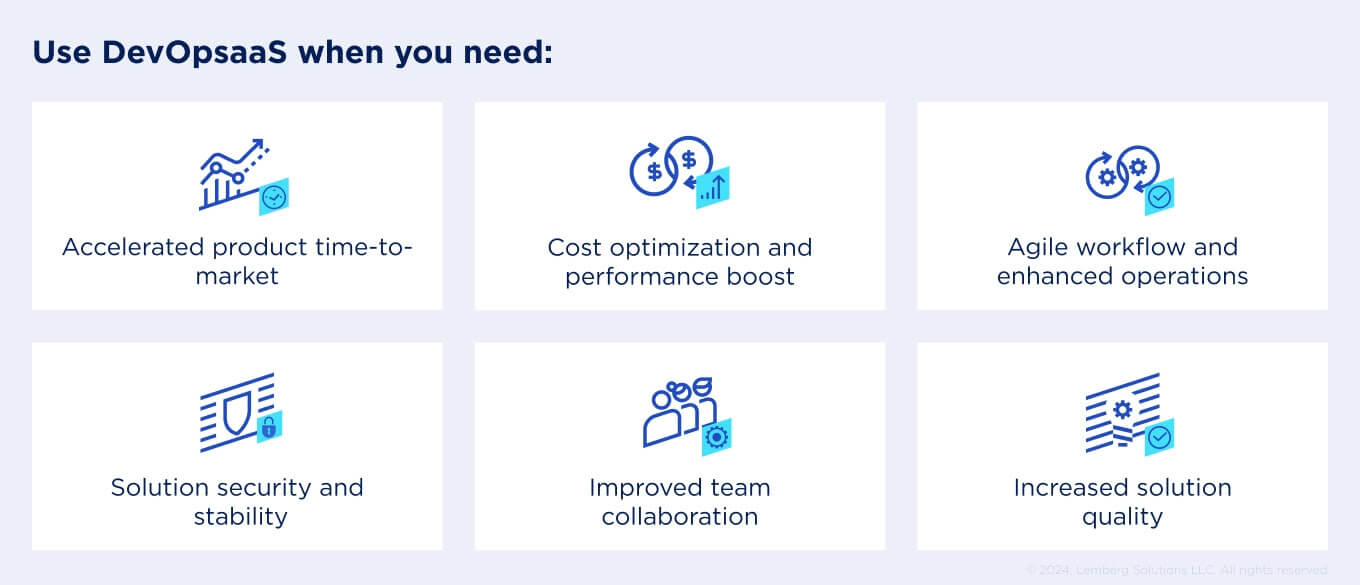We’ve interviewed our DevOps Team Lead Volodymyr Hekht to clarify why DevOps as a Service (DevOpsaaS) is an important part of many software development projects. Volodymyr has vast experience with IoT, web, and mobile projects. He helps our DevOps team deliver robust solutions that effectively cope with market competition and inspire trust among end users. He automated software lifecycle for numerous solutions and helped our clients get their products to market faster. DevOpsaaS is key to product stability and success since DevOps engineers take care of solution architecture — a foundation of any app.
In this article, you will learn when to leverage DevOps as a Service, what cloud platforms are the best for DevOps practices, and how we make sure that your solution performs as planned. Read more to learn about DevOpsaaS for your business.
Q: What is the difference between DevOps as a Service and DevOps services?
A: DevOps services and DevOps as a Service (DevOpsaaS) are two distinct approaches to implementing DevOps practices. DevOps services meaning typically refers to using DevOps principles by a company's own DevOps team.
Speaking about DevOps as a Service, I would say it involves outsourcing DevOps practices by a third-party provider. In this model, the service provider takes responsibility for setting up and managing your DevOps environment, including process automation and workflow optimization. This way, you can leverage the expertise and experience of external DevOps specialists without the need to build and maintain your own in-house DevOps team. DevOps as a Service offers a quicker and more cost-effective approach for organizations adopting DevOps practices. You won't need to invest in internal resources and expertise. Ultimately, the choice between DevOps service and DevOps as a Service depends on your priorities, resources, and strategic objectives.

Q: When do clients need DevOps as a Service?
A: DevOpsaaS can meet different project needs, including your product security and smooth market launch. Let's discuss the most important ones.

Faster time to market
The main reason why you need DevOpsaaS is to accelerate the time-to-market for your product. By reducing the time it takes to develop and deploy new features or updates, we’ve helped our clients gain a competitive edge in their industries. With properly set up DevOps, you can respond quickly to market demands and outpace competitors with longer development cycles.
Additionally, there are other important reasons for you to consider DevOpsaaS:
Cost optimization and performance boost
The providers of DevOps as a Service, like us, usually offer to build scalable infrastructure and resources. This allows you to pay only for what you use within the cloud environment. It’s a practical approach, which also helps you scale up or down depending on the current demand. We will also help you avoid over-provisioning and budget overruns. In our team, we focus on repetitive task automation (code deployment, testing, etc.), which reduces the need for manual intervention and saves time and labor costs. As a result, you can achieve higher productivity for development teams since they won’t need to manage infrastructure.
Agile workflow and enhanced operations
DevOpsaaS providers ensure the reliability and availability of your solution. We enhance and optimize your operations and it leads to increased customer satisfaction. With DevOpsaaS, your in-house teams operate in a more flexible way because we help them adapt to changes in priorities and requirements. Generally speaking, the development and operation teams have the needed space to iterate more easily and integrate new features into your solution.
Solution security and stability
DevOps engineers lay the foundation for your solution’s security and resistance to breaches and cyber attacks. We usually take care of automatic failover, which means automatically transferring an application to a backup server if a breakdown occurs. Moreover, we work on load balancing by distributing the network traffic between different servers. The team does so to ensure protection against hardware failures or infrastructure outages. We always recommend a backup setup to protect your data and applications against any data loss or downtime. This way, you can quickly recover from disasters and minimize downtime if an outage occurs. We recommend a disaster recovery plan with necessary risk assessment and recovery measures.
Improved team collaboration
The main task of DevOps is to establish strong cooperation between different teams responsible for different tasks so that they can operate as a single team. That is why we usually leverage specific collaboration tools, including version control systems, issue tracking, and communication channels. This way, I ensure that collaboration is smooth and there is no miscommunication when it comes to task prioritization and responsibility. This approach helps me to make sure that we respond rapidly to changes or issues.
Increased solution quality
With DevOpsaaS, you can identify any issues at the early stages of the development cycle. This helps to avoid any issue accumulation, which can impact the quality of the final product. We can deploy software changes automatically after doing the automated tests. If DevOps is effectively implemented, we can make small adjustments to a solution safely and quickly, gathering early feedback from the client. We can detect issues as soon as possible before they impact end users. This ensures that the final product is robust, reliable, and free from critical defects.
Q: What platforms do you frequently use to set up DevOps?
A: For starters, cloud platforms allow to accelerate the development process. We can leverage a cloud CI/CD system that allows us to keep everything you need within one space. Usually, clients want to use one cloud platform (e.g., AWS). However, if the cloud provider changes conditions or services, you will have to migrate to a different platform. Ideally, we recommend building a hybrid system using some services from AWS and some from Azure. In this case, we can easily transfer the data whenever the client requires it. It all depends on the client’s project requirements, budget, project scale, and plans for future solution growth.
Here are the services we often use for DevOps projects:

AWS CodePipeline
A continuous delivery service that helps to automate the necessary steps for product delivery and release. We can use AWS CodePipeline with other AWS services.
AWS CodeBuild
A continuous integration service that provides different types of tests for a software environment. It also generates artefacts that can be deployed.
AWS CodeDeploy
With this service, we can automate code deployment to the servers. Moreover, it can prepare the code and check whether it runs as planned.

Azure DevOps
This Azure service allows us to manage a project lifecycle flow in the form of task tickets (similar to Jira). With Azure DevOps, you can get automated CI/CD and code testing. You can also integrate it together with Azure Pipelines, which can be used for the development of different apps, including Android, C++, .NET, and so on.

Digital Ocean
An affordable, flexible, and high-performance cloud platform that allows to manage high workloads. The service helps to automate releases and accelerate development cycles.
We choose cloud platforms for DevOps as a Services based on a client’s demand, budget, and software requirements to make the most suitable environment for solution development.
Q: How does the DevOps process usually look like in your team?
A: Basically, in our team, we start with transparent communication and establishing requirements for the project. DevOps is about the right approach to project launch and guaranteeing its success if we have worked out all the necessary aspects. We divide the project development process into four steps:

1. Strategy development and estimation
When you need to solve any challenges with your project, we collect your requirements and goals to make sure we are on the same page. At the same time, we develop a suitable strategy that will help you gain a foothold in the market. Our team estimates the scope of work and timeline, as well as analyzes possible risks that may arise during project development. The cloud architect at Lemberg Solutions chooses which resources and tools to use for the project.
2. Environment set-up and process automation
The team leverages infrastructure-as-code (IaC) scripts to set up project infrastructure and configure the servers. When the infrastructure is ready, we apply configuration management tools to check whether each infrastructure component works as planned. After that, we can install software and build a CI pipeline to automate development, testing, and deployment. Our DevOps engineers configure monitoring tools to ensure the software's stable performance. These tools help us detect any issues early on and fix them immediately. Last but not least, we configure security by setting access controls and firewalls. Regular audits are also a must for your project’s data protection.
3. Testing and release configuration
During this stage, we write testing scripts to verify whether all components perform well. Next, we automate testing, which accelerates this process. This is especially helpful when we integrate any changes and need to test the system to check whether it still works as intended. However, we still need to confirm that the test results are correct. If we still find the issues, the team fixes them before releasing the changes. Our DevOps engineers leverage version control to track changes and reverse them if needed.
4. Support and maintenance
For the support and maintenance stage, we establish procedures for integrating updates and system changes. After the product release, we monitor software performance, assess user experience, evaluate system stability, and collect feedback. Depending on the feedback, we implement needed modifications and adjust our DevOps practices to the product. If any unexpected issues occur, we fix them to avoid any downtime that impacts your end users.
Following all these stages, we make the DevOps platform as a service a convenient and effective process to develop your software and ensure it’s ready for market release.
Q: What do you deliver to the client as a part of DevOpsaaS?
A: DevOpsaaS includes developing a robust cloud strategy, facilitating cloud adoption, and establishing secure cloud environment. By collaborating with the client from the start, we understand their goals and constraints, which helps to align client’s vision with our cloud strategy. If you have already implemented a solution within the cloud environment that doesn’t benefit you, we will help with cloud migration. If you plan to build your software within the cloud platform, we will choose the best plan that fits your needs and budget. Our team implements automation and issue monitoring to improve solution reliability.
We take over cloud architecture design to ensure your software runs smoothly on a layered architecture. DevOps as a service model within our team focuses on getting your product to the market faster to get ahead of the competition. We will also ensure that you can measure your progress and scale the solution. You will get your routine tasks automated, which accelerates update integration. You can also track cloud costs and adjust them to your budget and demand.
Our company takes serious measures to ensure your data security. We obtained ISO 9001:2015 and ISO 27001:2013 certifications that prove our effective quality management and data protection of your project. DevOps engineers at Lemberg Solutions maintain security testing to ensure your software resilience. We assess your software, identify potential vulnerabilities, and monitor the system for known vulnerabilities to handle them. Our team integrates security testing into the CI/CD pipeline to address the issues proactively. This way we protect your data from unauthorized access, enhance your company’s reputation, and build trust with your end users.
Q: Which of your projects have considerably benefited from DevOps as a Service?
A: We've developed numerous projects using the best DevOps practices. I will discuss the main three, which I consider the best examples of effective DevOpsaaS.
IoT telemedicine platform for cough sound recognition
At first, let’s talk about our development of a healthcare device for home-based patient monitoring. The device collects audio data and sends it straight to the cloud for further processing. Our DevOps team deployed software within the Azure cloud platform. We automated data processing, security monitoring, and metrics visualization. Additionally, our engineers automated the deployment of cloud environments (IaC) and configured CI/CD and autoscaling.
Check out the full case study.
IoT web application for workplace noise monitoring
The next project I’d like to mention is our re-engineering of the existing noise management solution and development of the front and back end for the client’s web app. In this case, we used the Amazon platform. Our DevOps engineers configured IaC and CI/CD. We automated environment deployment, cloud monitoring, scaling, and security alerts. To optimize the client’s costs, we connected environments.
Read about the project in detail.
A fleet intelligence dashboard for a Safety-aaS solution
We also cooperated with a German company that creates AI-based software to improve road safety. Our cloud and DevOps team worked within the Amazon cloud platform. We developed a cloud infrastructure from scratch and used Amazon DocumentDB as a database. Our team configured cloud monitoring using the AWS Cloud Watch service. Additionally, our DevOps experts automated security monitoring and solution scaling for demand changes.
As a result, our clients have accelerated software development, optimized cloud costs, and flexibility for solution growth.
Learn more about our project development.

Takeaway
DevOpsaaS is a vital component of modern software development allowing you to create scalable and reliable solutions. With DevOps experts on board, you receive a streamlined software development cycle, accelerated time-to-market, enhanced productivity, and optimized costs. DevOpsaaS allows you to focus on important business operations while routine tasks have been automated. You get continuous software improvement and security monitoring, which leads to a high-quality, stable, and high-performance solution that meets your evolving requirements and market changes.
If you need help with establishing a reliable architecture for your software solution, don’t hesitate to contact us. We will consult you on your software development needs and help you with end-to-end product development.




